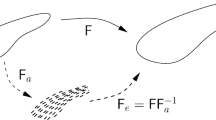Abstract
Many biological tissues exhibit a non-standard continuum mechanics behavior: they are able to modify their placement in absence of external loads. The activity of the muscles is usually represented in solid mechanics in terms of an active stress, to be added to the standard one. A less popular approach is to introduce a multiplicative decomposition of the tensor gradient of deformation in two factors: the passive and the active one. Both approaches should satisfy due mathematical properties, namely frame indifference and ellipticity of the total stress. At the same time, the constitutive laws should reproduce the observed physiological behavior of the specific living tissue. In this paper we focus on cardiac contractility. We review some constitutive examples of active stress and active strain taken from the literature and we discuss them in terms of precise mathematical and physiological properties. These arguments naturally suggest new possible models.
Similar content being viewed by others
References
Ambrosi, D., Arioli, G., Nobile, F., Quarteroni, A.: Electromechanical coupling in cardiac dynamics: the active strain approach. SIAM J. Appl. Math. 71, 605–621 (2011)
Antman, S.S.: Nonlinear Problems of Elasticity. Springer, New York (2005)
Böl, M., Abilez, O.J., Assar, A.N., Zarins, C.K., Kuhl, E.: Computational modeling of muscular thin films for cardiac repair. Comp. Mech. 43, 535–544 (2009)
Campbell, K.B., Simpson, A.M., Campbell, S.G., Granzier, H.L., Slinker, B.K.: Dynamic left ventricular elastance: a model for integrating cardiac muscle contraction into ventricular pressure-volume relationships. J. Appl. Phys. 104, 958–975 (2008)
Cherubini, C., Filippi, S., Nardinocchi, P., Teresi, L.: An electromechanical model of cardiac tissue: constitutive issues and electrophysiological effects. Prog. Biophys. Mol. Biol. 97, 562–573 (2008)
DiCarlo, A., Quiligotti, S.: Growth and balance. Mech. Res. Commun. 29, 449–456 (2002)
Downey, J.M.: The mechanical activity of the heart. In: Johnson, L.R. (ed.) Essential Medical Physiology, 3rd edn., pp. 201–213. Elsevier, Amsterdam (2003)
Göktepe, S., Kuhl, E.: Electromechanics of the heart: a unified approach to the strongly coupled excitation–contraction problem. Comput. Mech. 45, 227–243 (2010)
Holzapfel, G.A., Ogden, R.W.: Constitutive modelling of passive myocardium: a structurally based framework for material characterization. Philos. Trans. R. Soc. Lond. Ser. A, Math. Phys. Sci. 367, 3445–3475 (2009)
Iribe, G., Helmes, M., Kohl, P.: Force-length relations in isolated intact cardiomyocytes subjected to dynamic changes in mechanical load. Am. J. Physiol., Heart Circ. Physiol. 292, H1487–H1497 (2007)
Liu, I.-S.: Continuum Mechanics. Springer, New York (2002)
Merodio, J., Ogden, R.W.: Mechanical response of fiber-reinforced incompressible non-linearly elastic solids. Int. J. Non-Linear Mech. 40, 213–227 (2005)
Murtada, S., Kroon, M., Holzapfel, G.A.: A calcium-driven mechanochemical model for prediction of force generation in smooth muscle. Biomech. Model. Mechanobiol. 9, 749–762 (2010)
Nardinocchi, P., Teresi, L.: On the active response of soft living tissues. J. Elast. 88, 27–39 (2007)
Nardinocchi, P., Teresi, L., Varano, V.: Myocardial contractions and the ventricular pressure-volume relationship. ar**v:1005.5292v1 [q-bio.TO] (2010)
Niederer, S.A., Smith, N.P.: An improved numerical method for strong coupling of excitation and contraction models in the heart. Prog. Biophys. Mol. Biol. 96, 90–111 (2008)
Panfilov, A.V., Keldermann, R.H., Nash, M.P.: Self-organized pacemakers in a coupled reaction–diffusion-mechanics system. Phys. Rev. Lett. 95, 258104 (2005)
Pathmanathan, P., Chapman, S.J., Gavaghan, D.J., Whiteley, J.P.: Cardiac electromechanics: the effect of contraction model on the mathematical problem and accuracy of the numerical scheme. Q. J. Mech. Appl. Math. 63, 375–399 (2010)
Redaelli, A., Pietrabissa, R.: A structural model of the left venricle including muscle fibres and coronary vessels: mechanical behaviour in normal conditions. Meccanica 32, 53–70 (1997)
Rodriguez, E.K., Hoger, A., McCulloch, A.D.: Stress-dependent finite growth in soft elastic tissues. J. Biomech. 27, 455–467 (1994)
Smith, N.P., Nickerson, D.P., Crampin, E.J., Hunter, P.J.: Multiscale computational modelling of the heart. Acta Numer. 13, 371–431 (2004)
Stålhand, J., Klarbring, A., Holzapfel, G.A.: Smooth muscle contraction: mechanochemical formulation for homogeneous finite strains. Prog. Biophys. Mol. Biol. 96, 465–481 (2008)
Taber, L.A.: Towards a unified theory for morphomechanics. Philos. Trans. R. Soc. Lond. Ser. A, Math. Phys. Sci. 367, 3555–3583 (2009)
Taber, L.A., Perucchio, R.: Modeling Heart Development. J. Elast. 61, 165–197 (2000)
Whiteley, J., Bishop, M., Gavaghan, D.: Soft tissue modelling of cardiac fibres for use in coupled mechano-electric simulations. Bull. Sci. Math. 69, 2199–2225 (2007)
Author information
Authors and Affiliations
Corresponding author
Rights and permissions
About this article
Cite this article
Ambrosi, D., Pezzuto, S. Active Stress vs. Active Strain in Mechanobiology: Constitutive Issues. J Elast 107, 199–212 (2012). https://doi.org/10.1007/s10659-011-9351-4
Received:
Published:
Issue Date:
DOI: https://doi.org/10.1007/s10659-011-9351-4




